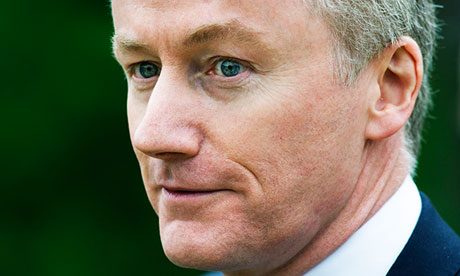
Do not read this book if you have high blood pressure. The collapse of RBS; the multibillion-pound bailout (courtesy of you and me), and the smug indifference of the guilty men is one of the parables of the ills of contemporary capitalism. Iain Martin tells it brilliantly, mixing fury-inducing narrative with an acute eye for the broader conclusion. Of all the many tales about the global financial crash, I have not read a more compelling one.
The star of the show, the pantomime villain, is Fred Goodwin, aka Fred the Shred (a nickname he apparently quite liked), a man who made up for his ignorance about the complexities of banking with hubris and bullying.
His story (in a nutshell): modest home in Paisley (although not nearly as "salt of the earth" as he would have people believe), trains as accountant, moves into banking, takes over the Clydesdale, is head-hunted for RBS… and the rest is opprobrium.
The bank's story (in a nutshell): formed shortly after the acts of union, expands into England to exploit the wealth from empire in the late 19th century, known for centuries for its canny management of money, following the Thatcher "big bang" it wants to join the global league. Cue Fred.
In 1998, Goodwin was brought in as deputy chief executive and, together with his board, set about the great aggrandisement of the Edinburgh-based bank. He had already acquired a reputation as someone not to be messed with. One former employee tells the author "he manufactured fear".
In the first months of the new millennium, RBS succeeded in a hostile takeover of NatWest. It was an extraordinary coup, redolent with political as well as economic messages. Bonnie wee Scotland could invade London and get away with it. In one swoop, RBS had become Europe's second largest bank and the fifth largest in the world by market capitalisation. Just five years earlier he hadn't even been a banker. At the age of 42, he was now one of the most powerful in the world. It got better and better: in 2003, Forbes magazine made him its global businessman of the year, putting him on the cover and running a gushing interview with him. Harvard Business School was equally fawning in a report it produced the following year.
Goodwin's ego was going into orbit. He ordered that a new headquarters be built, conveniently close to Edinburgh airport and his private jet. He spent hours on the architectural plans, focusing on the idea of a large fountain and an external reflection pool. He was obsessed with the executive car fleet. The colour of each car had to be a particular blue called Pantone 281.
Everyone wanted a slice of him. The royal family loved him. He was a big name behind the Prince's Trust, later to be appointed to the Queen's Silver Jubilee Trust. When the request went to Buck House for Her Maj to open his egotistical folly, acceptance was swift. The knighthood was in the bag.
The only thing that mattered to Goodwin was growth. He was on the prowl for the next takeover. The hapless board waved through each plan (in so far as he bothered to tell them). Their lack of curiosity or knowledge of complex issues was, as the author points out, a disgrace, but an inevitable consequence of the "you scratch my back" culture of corporate life. Goodwin's own knowledge of collateral debt obligations, credit default swaps or over-leveraging against US sub-prime mortgages was equally rudimentary. Anyone who aired doubts was shouted at or sidelined.
Senior politicians were credulous and indulgent. Back in 2000, the Cruickshank report on banking competition said banks should be prevented from becoming too big. The Treasury quietly shelved it. In Scotland, Alex Salmond and the others mounted chippy defences of the underdog north of the border whenever it was challenged. As for Tony Blair and Gordon Brown, they lampooned the indignity of regulation. In his final Mansion House speech as chancellor, in June 2007, Brown praised the "new golden age for the City of London". This, the author notes with a delicious dry wit that permeates this grim tale, was "Panglossian propaganda for a doomed experiment. It was delusional drivel."
A few months later, just when the holes in its finances were growing into a chasm, the takeover of ABN Amro tipped RBS over the edge. Brown and his team emerge well from the fevered rescue days, helping to prevent the collapse of the entire financial system. But it was they who encouraged the spiv culture to begin with, hoping that the trickle of taxes emanating from the banks' enormous profits would do some social good.
Goodwin has been pilloried. He now spends his time tending to his fleet of classic cars (the annual £700,000 pension softens the blow somewhat). He lost his knighthood and will be the object of historians' ridicule. Yet, as Martin points out, to fixate on him is to let the rest get away Scot free (pun partly intended). Nobody important has gone to jail, stratospheric bonuses are back, and, as the author points out, the changes being introduced into the banking sector are little more than tinkering.
Imagine telling a teenager they can walk into a phone or clothes shop and take what they like, knowing that the security guard at the front has been ordered from on high to go on a perpetual lunch break. That was the culture of banking during the so-called boom years. Fred was just one among many.
John Kampfner's latest book, The Rich: a History, will be published next year by Little, Brown. twitter@johnkampfner

